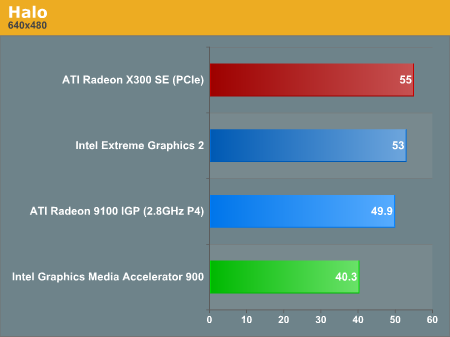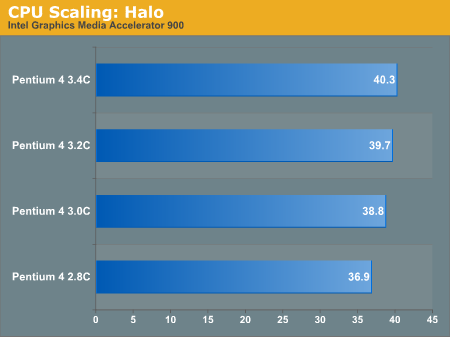Intel 915 Graphics: Graphics Media Accelerator 900
by Derek Wilson on August 2, 2004 10:03 AM EST- Posted in
- GPUs
Halo Performance
Neither of these cards can render Halo in its full glory, but the Intel solution seems to have a tougher time of it. These screenshots don't really show the difference well, but they do a good job of showing that Halo is still a visually impressive game at low resolution with few features enabled.
Graphics Media Accelerator 900

Radeon 9100 IGP
Performance shows the Intel Extreme Graphics 2 trailing only the X300, but this is absolutely because the Extreme Graphics did a horrid job rendering this game. Way too many details were left out for this to be a comparable benchmark, but we left the numbers in for the sake of completeness of the article.


CPU scaling shows a bit of a bump between 2.8GHz and 3.0GHz, indicating that this is the point where non-graphics CPU bottlenecks drop in impact to overall performance.










18 Comments
View All Comments
IntelUser2000 - Tuesday, September 28, 2004 - link
Well, I can't believe that Anandtech can do this. Look at the Intel Graphics drivers, which are 6.14.10.3756The latest is: 6.14.10.3889
The difference in those two is that 3889 has support for GMA900, which will make a lot of difference in performance.
LoneWolf15 - Friday, August 6, 2004 - link
The reason I feel Intel has an obligation is far more than just because they are the #1 graphics chipset supplier in the world.Most systems that offer an IGP like the EG2 or GMA 9000 lack an AGP slot or a PCIe slot for a performance graphics card, so the manufacturer could save a few bucks. This absolutely dooms the entry-level user that knew little about graphics at the time of their computer purchase. It wouldn't bother me so much if users could easily replace the Intel solution with a top-flight graphics card, but in a lot of systems, this isn't the case. I feel that a current IGP should have close the power of a Geforce 4MX, or a Radeon 9200, hampered only by the shared-memory architecture, which will always hold these chips back. Either that, or there should be a clear upgrade path to a new graphics card. Seems business customers get the elevator in this case, but the home users get the shaft.
T8000 - Tuesday, August 3, 2004 - link
I think the Intel "Extreme" graphics are well worth their $3 premium, but they are meant for business desktops (and notebooks), so a review like this is just another way of saying you should buy an add-in graphics board for gaming.Just remember that more then half of the PC's sold will never see a 3d game, making such a graphics solution a great way to cut costs for those PC's.
tfranzese - Tuesday, August 3, 2004 - link
I am NOT inferring anything about performance. I am stating that the quality of the hardware is only as good as the software running it, which in this case are poor drivers. Intel's product is up there with the worst of them when it comes to proper drivers. In order for it to be a proper driver it should be able to render scenes properly as a customer would typically expect from such a big name.I havn't been criticizing performance, how fast it can render scenes. That point is easily assumed with it being an IGP. It doesn't excuse the fact though that the software is shite. And there is PLENTY in the article to support that indirectly with the screen captures and comments.
Surprisingly the article fails to even cover Intel's driver and software presentation and integration.
mikecel79 - Tuesday, August 3, 2004 - link
#13 you are equating performance with reliabilty and quality. You don't say it, but it's infered. Here's an example maybe you can understand.A Civic is a well made reliable car using quality parts. It has amongst the highest quality in the inudstry. However it's performance is lacking in comparision to say a Corvette. Does that mean it is not a reliable, quality product? No of course not. So your statement is wrong. There is NOTHING in this article to show that Intel graphics are not reliable, and are of low quality. So it's not as fast as a add-in card. It doesn't make it a low quality or unreliable product.
tfranzese - Tuesday, August 3, 2004 - link
And, where did I mention the performance? It certainly is poor (and Trogdor, the only thing stupid is your comparison which is severely lacking), but if you actually read the article there are plenty of times poor image quality and errors are brought up. And this quote to be specific:"But we feel that being the number 1 supplier of graphics solutions in the world, Intel has a responsibility to uphold to the population of our small corner of the galaxy. By providing poor support for current technology to such a wide number of people, Intel is doing more harm than good. Obviously, there is a place for the GMA900, and we wouldn't be so hard on Intel if they could at least offer a performance based integrated solution for those who actually want compatibly, performance, and a good price point with their new system."
And that's putting it nicely after seeing three of these benchmarks of some pretty popular games display incorrectly. If you people call that a 'realiable' and 'quality' product from a company who holds more than the majority of market share I'd have to suggest you all get your eyesight checked.
tfranzese - Tuesday, August 3, 2004 - link
IMO, the quality of the hardware is only as good as the software - and there is nothing quality about it, nor reliable in delivering what a customer might expect.Stupid comment, no. Has plenty of ground to stand on here.
TrogdorJW - Monday, August 2, 2004 - link
#2 - Yeah, this is the Intel quality and reliability, and as you can see from the article, it absolutely destroys the graphics solutions made by AMD. It's infinitely faster than those. :p (Sorry, but one stupid comment deserves another.)Given the cost of integrated graphics - about what, $5 extra, maybe $10? - it's not too surprising to see performance this low. I do have to agree that it's rather stupid to even include integrated graphics on the latest and greatest "high end" PCs, though. A server motherboard could add an old Rage 2c chip (like most already do), while for a desktop, I can't think of a good reason to get a 3.6E 775-LGA system that doesn't involve at least running an X300. Well, I can, and that reason is "marketing".
Still, it's just one more way for Dell to screw over customers. I'm waiting for the Dell systems based off of the 915 and 925 chipsets to start shipping *without* the PCIe X16 ports. (Unless they're already available?)
thebluesgnr - Monday, August 2, 2004 - link
#7,There's no nVidia IGP for socket 754/939. I think they would rather have people buying discrete graphics (from them), so they will only release an IGP chipset when they "have to", that is, when SiS760 and VIA K8M800 gain some market share. Right now socket 754 is still expensive so integrated motherboards are not very popular.
Marlin1975 - Monday, August 2, 2004 - link
kmmatney, the only IGP for the A64 so far is the Unichrome pro from VIA, whihc is not meant for 3D at all, but has a built in mpeg decoder etc...There was really no reason to have IGP for the A64 as the chips USE to soct so much that buying one and trying to use a IGP is liek a EE P4 on a IGP board. But now that he socket 754 sempron and the price reduction of the 2800 and 3000, I am sure there will be a nForce IGP chipset coming soon.